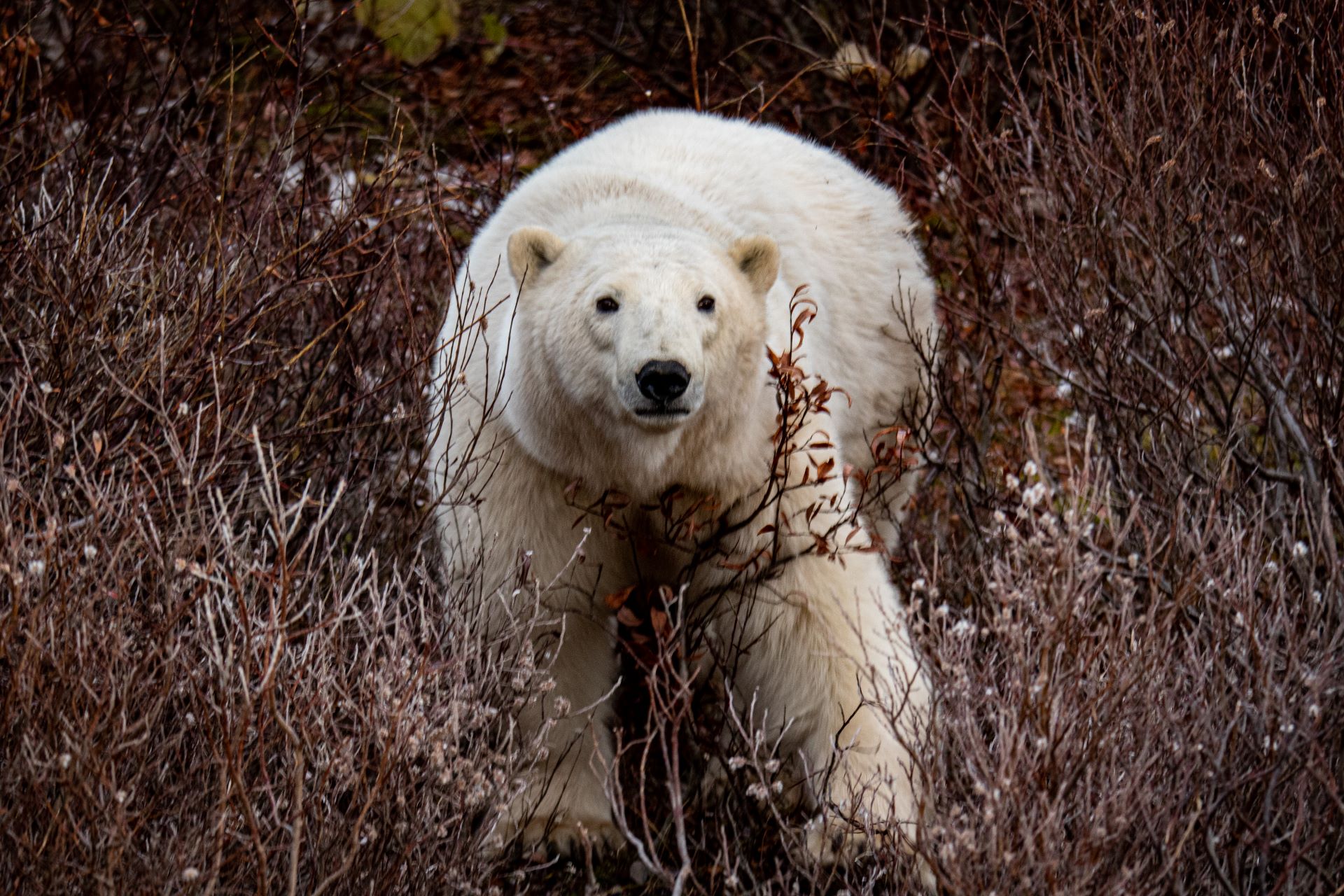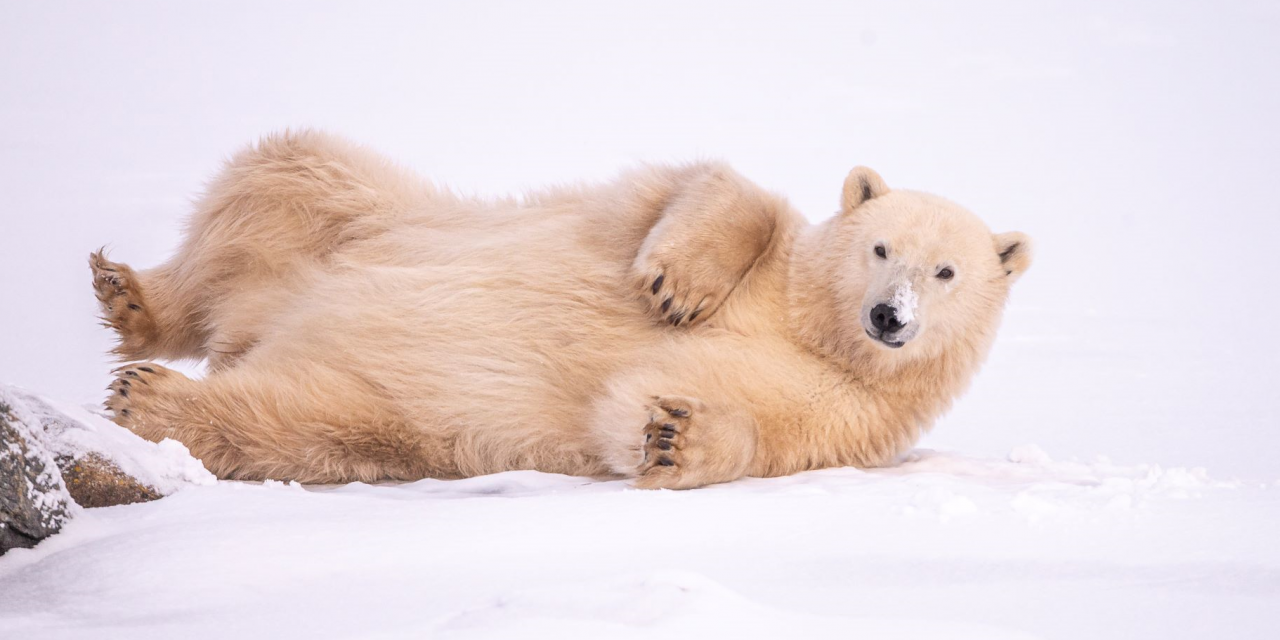Polar bears (Ursus maritimus) are in the news all the time as the “poster animal” of climate change, but outside of the fact that they are big, look white (yes, that “look” part is important!), the majority hang out in Churchill, Canada, and their habitat is in severe danger, what else do most people really know about them?
Here are eight facts about polar bears that will leave you even more enamored with these beastly beauties. There’s definitely a lot more to these Arctic-dwelling bears than what most wildlife lovers know.
1. They actually share food quite nicely with Arctic foxes
You might think a massive, gnarly, hungry polar bear would gobble up any animal that came close. But nope—efficient polar bears in normal conditions tend to only eat animals with lots of high-calorie fatty blubber (makes sense why they have a preference for marine animals). When food is abundant, they won’t touch Arctic foxes and often even share food with them. The polar bear has what’s called a mutualistic symbiotic relationship with Arctic foxes. The polar bear, after gnawing on the blubber of a marine animal, will usually leave the meaty part of the carcass behind. Arctic foxes follow polar bears and scavenge on these remains.

They’re also polite sharers amongst themselves. When they have access to larger marine mammals such as beluga whales, there can be over 3,000 pounds of food to share amongst a group of polar bears. When one polar bear wants to share another bear’s food, they’ll slowly circle their way towards them and gently touch noses to ask if they can share.
2. They’re the only carnivorous bear
Although most bears are omnivores, meaning that they live off a diet of both animals and plants, there isn’t exactly an abundance of plant life in the arctic tundra. Polar bears are carnivorous, and their primary diet is ringed and bearded seals. That being said, polar bears are opportunistic hunters and in the summer, when they can’t hunt seals, will at times turn to many other food sources to survive. This can include birds, terrestrial mammals and even vegetation such as algae and berries. For this reason, some scientists prefer to classify them as hypercarnivores—animals whose diets are composed of more than 70% meat. But in perfect polar bear conditions, they would happily munch on only seals and that would be that. A polar bear can burn through 12,325 calories per day; that equates to a female having to eat either one large adult seal, three small adult seals or nineteen newborn seal pups every week and a half just to maintain her body mass. I can’t even imagine how many plants they would have to eat to cover their caloric needs!
3. If you happen to be a lost arctic explorer, think twice about eating polar bear meat
Although it’s illegal for most people to hunt polar bears, there are usually some exceptions for Indigenous populations who have relied on them as a source of food for many hundreds of years. But, they definitely know what they are doing. Polar bear meat must be very well cooked, as it often is filled with Trichinella spiralis parasites. These cause trichinosis, which in severe cases can cause death. Eating polar bear liver is also incredibly dangerous, because it is so high in vitamin A that it can cause Hypervitaminosis A in humans—a freaky, deadly disease that can cause your hair to fall out and your skin to peel. In the past, many hungry explorers who probably celebrated before they feasted have unfortunately died from eating raw polar bear meat.

© Brad Josephs
4. The distances they can swim are almost unbelievable
Because they prey on seals and whales, it shouldn’t come as any huge shock that polar bears are decent swimmers. But between their big, slightly webbed paws and a hollow outer layer of fur that gives them added buoyancy, they are actually amazing swimmers. They have to be, as they migrate long distances by water when moving from the melting sea ice to islands or the mainland. Each migration is over a hundred miles on average, but there are polar bears on record for having traveled more than 425 miles in a single swim. That’s more than nine days straight through—three times the longest distance ever swam at once by a human!
5. Polar bears aren’t actually white
Wait, what? Yup, it’s true. Polar bears have two layers of fur. One is a short undercoat and one is made up of longer “guard hairs.” While it might seem by looking at a polar bear that these hairs are be white, they’re actually translucent. They only look white because they reflect the sunlight.

© Brad Josephs
Sometimes on our Premier Polar Bear Adventure, we see polar bears under a gray sky and they appear gray. At sunset, they can have a tinge of red to them. They can also even appear green in captivity: Rough concrete pens can cause tiny holes to form in the guard hairs, letting algae in to grow, especially when they are kept in warmer climates. Another fun fact is that while all other bears have pink skin underneath their fur, polar bears actually have black skin.
6. They have the most sensitive nose of any land mammal
Polar bears can hear a slightly wider range of frequencies than humans (up to 25 kHz), and their eyesight is also similar to that of humans (although they do have a protective membrane over their eyes that helps shield them from ultraviolet light). But polar bears’ sense of smell is a whole other matter. According to the folks at Guinness World Records, polar bears have the most sensitive nose of any mammal that lives on land. They can smell prey up to 20 miles away! Even if an animal is hiding under three feet of dense snow, they can’t hide from a polar bear. The bear will smell them with zero problem.
7. Females polar bears can give birth to cubs from different fathers at the same time
Polar bears are polygynous and will hardly ever mate with the same bear in different years. Male polar bears are definitely not paternal. After mating, the male polar bear will only hang out with the female for a few days before leaving. The female does what she wants as well, often mating with another partner in the same breeding season. This can end up with her giving birth to offspring from different fathers at the same time.

© Colby Brokvist
While most polar bears don’t hibernate like other species of bear (they spend winter on the sea ice hunting seals and building up their fat reserves for the food-scarce summer on the mainland), pregnant polar bears do enter a hibernation-like state. They will go into their den around October, with cubs being born around 60 days later. They stay in the den for around seven to eight months until the cubs can leave. During this time, they remain in a reduced metabolic state and they don’t eat, drink, urinate or defecate to save energy.
8. Unfortunately, the polar bear is the poster animal for climate change for good reason
It’s no secret that polar bears are facing serious threats from the changing climate.
They absolutely rely on the arctic sea ice to access seals, whales and other marine mammals for food. They must build up their fatty reserves before heading to the food-scarce mainland or islands for the summer. However, with the sea ice melting earlier and earlier each year, they don’t have adequate time to build up these very necessary fatty reserves.

© Lianne Thompson
Despite the obvious fact that they could easily hunt humans if they wanted, polar bears try to avoid confrontation. A review of attacks by polar bears on humans between 1970 and 2014 reported only 20 deaths in that whole time across their entire range, including Canada, Greenland, Norway, Russia and the United States. But climate change could mix things up and make hungry polar bears desperate. Malnourished bears are the most likely to attack humans at campsites and Inuit settlements.
Scientists now estimate that there are fewer than 26,000 polar bears left in the wild, and given the current state of environmental affairs, they may be extinct by the end of the century. If you have interest in seeing these beautiful creatures in the wild, there is no better time than now. You can feel good about your part in sustainable tourism, as we partner with the World Wildlife Fund. WWF has spent many years working with tourism operators in areas inhabited by polar bears to find ways to not only limit the impact of tourists on the bears and their habitat but actually contribute to conservation efforts. The result of their work was a strong and clear set of principles for arctic tourism. On our trips we happily follow their lead for how to best interact with these creatures for the good of all.

























